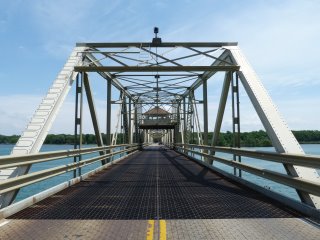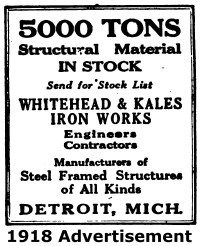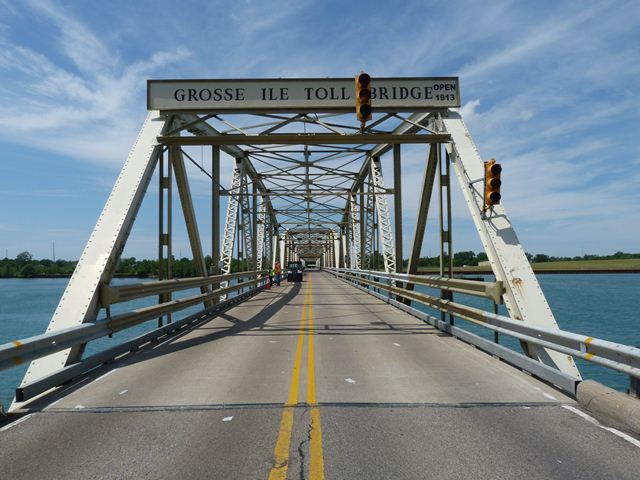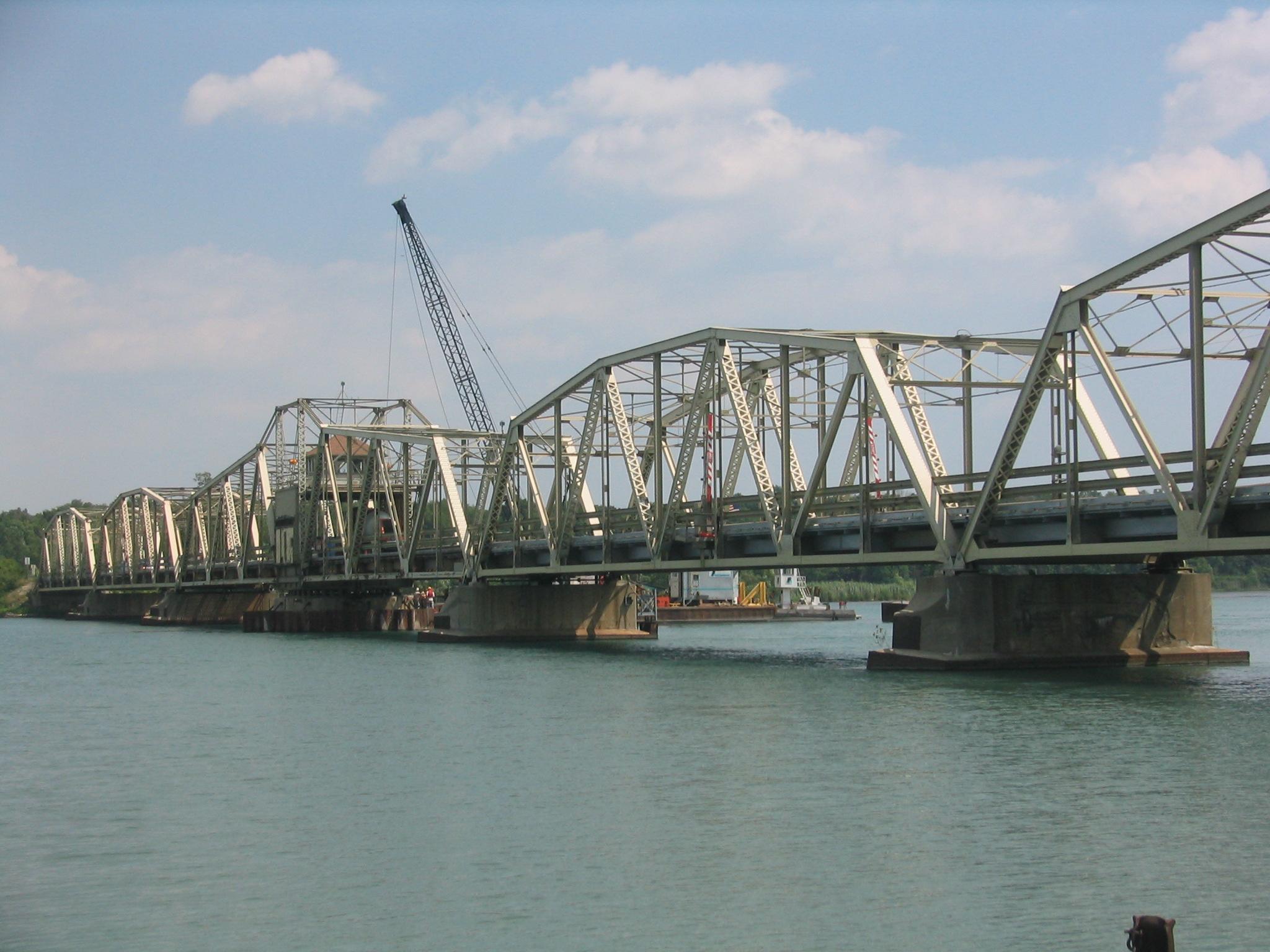We Recommend:
Bach Steel - Experts at historic truss bridge restoration.
BridgeHunter.com Phase 1 is released to the public! - Visit Now
Grosse Ile Toll Bridge
Bridge Road Bridge

Primary Photographer(s): Nathan Holth
Bridge Documented: May 29, 2012 and August 1, 2005
Grosse Ile: Wayne County, Michigan: United States
Metal Rivet-Connected Polygonal Warren Through Truss, Movable: Swing (Rim Bearing Center Pier) and Approach Spans: Metal 8 Panel Rivet-Connected Polygonal Warren Through Truss, Fixed
1913 By Builder/Contractor: Whitehead and Kales Company of River Rouge, Michigan and Engineer/Design: Detroit Bridge and Steel Works of River Rouge, Michigan
Not Available or Not Applicable
304.0 Feet (92.7 Meters)
1,030.0 Feet (313.9 Meters)
21.3 Feet (6.49 Meters)
1 Main Span(s) and 4 Approach Span(s)
Not Applicable

View Information About HSR Ratings
Bridge Documentation
View Archived National Bridge Inventory Report - Has Additional Details and Evaluation
Visit the Official Grosse Ile Bridge Company Website
View A Grosse Ile Toll Bridge Facts Website
View Historical Articles And Advertisements Relating To Whitehead and Kales
View A Historical Biography of Edward W. Voigt
View A Documentary Video About The Bridge
Note: Thanks are due to Paul Smoke and Greg Karmazin of the Grosse Ile Toll Bridge Company for providing information and access that assisted in the research and photo-documentation of this bridge.
Bridge Design and Significance

This impressive historic bridge contains a through truss swing span which is complimented by two fixed through truss approach spans on either side of the swing span. The configuration of the fixed approach spans are polygonal Warren through truss. The through truss swing span also uses a Warren truss configuration. With a 1913 construction date, the Grosse Ile Toll Bridge is much older than the only other bridge to the island. Composed of riveted trusses with built-up beams, there is v-lacing on diagonal members, and lattice under the top chord. Original guardrails do not remain on the bridge. Original guardrails were wooden.
This bridge is one of the longest metal truss bridges in Michigan, and one of only a few remaining highway swing bridges in Michigan. It also is one of only a few remaining through truss bridges in Michigan with riveted connections. Michigan is extremely unusual in that it has far more of the older pin-connected through truss bridges than it does through truss bridges with riveted connections as were built in the 20th Century, likely due to the state's mostly small rivers (that could be accommodated by riveted pony trusses instead) and also the state's quick move toward concrete bridges. Unlike most states, Michigan State Highway Department never even developed a standard plan for a through truss. As such, the Grosse Ile Toll Bridge's riveted connections stand out as extremely rare in Michigan.
Bridge Structure Historical Facts
Before the existing swing bridge was built, an earlier plan for constructing a bridge at the northern end of Grosse Ile had considered a bridge that would connect Oak Street in Wyandotte to the northern tip of Grosse Ile. This structure was planned to be a bascule bridge rather than a swing bridge.
The original plans for the existing swing bridge included a provision for the future addition of sidewalks to the bridge. These sidewalks, which would have been cantilevered off the sides of the trusses would have included a traditional riveted lattice hand railing.
The bridge was reported to have cost $160,000 to construct.
Sadly, a structurally separate Queenpost pony truss bridge, located on the causeway on the eastern end of the crossing was removed in 2002 and replaced with an unremarkable new beam bridge. If there was no way to rehabilitate and continue using these attractive and rare Queenpost trusses, it would have been nice to see them placed on the replacement bridge as non-functional decorations to remind travelers of the original historical appearance and design. Original plans for the Queenpost span do remain, so future preservation work could include the exact replication of these lost truss panels.
The original rim bearing system on the bridge has been replaced in kind. The Grosse Ile Museum is reported to have the old bearing.
Like most bridges built during this time, the bridge originally had plaques mounted on it, one at each end of the bridge. However, one of the plaques was stolen and not recovered, and the other plaque was almost stolen. As for this second plaque, apparently some kids managed to remove the large, heavy plaque and were apparently trying to wheel it away in a wagon. They apparently had to walk past the toll booth to get back to where they were going, and the observant toll collector noticed the plaque in the wagon and so they were caught in the act and the plaque recovered. Today, the plaque is stored in a secure location. HistoricBridges.org has a couple photos of the plaque in the photo galleries, and the text of the plaque is shown below.
|
Main Plaque THIS BRIDGEWAS ERECTED BY THE GROSSE ILE BRIDGE CO. OF DETROIT MICH. OFFICERS E. W. Voigt - - - President F. A. Schulte - Vice President Orla B. Taylor - Secretary H. P. Borgman - - Treasurer Work started May 1912 Work completed Nov. 1913 |
Freighter Collisions and Subsequent Fixed Span Replacement
A tragedy befell the bridge on August 6, 1965 when freighter John T. Hutchinson hit the fixed span immediately to the east of the swing span, knocking the span in the river. A similar incident occurred again on September 1992, when the same fixed span, directly to the east of the swing span, was again hit and knocked into the water, this time by the freighter H. Lee White, a 700 foot vessel which was carrying 67 million pounds of iron ore. The span was replaced with a near replica which was designed based on the original plans for the 1913 span. Even built-up beams with lattice and v-lacing were replicated, rather that substituting them for modern, unsightly rolled beams like many other bridge owners might have done. The only shortcoming of the near-replica is that the span was bolted, not riveted, although the bolts were made to look partially like rivets due to their round heads. All in all it is a pretty impressive effort considering that built-up beams with v-lacing have not been used for decades. The casual visitor to this bridge would not even know the span was replaced, because the span looks like all the others except for the bolts.
Today most of the boat traffic that the bridge opens for is recreational in nature, although the occasional freighter does still come through, though nowhere near the numbers that the bridge once saw.
Details on Bridge Builders
The February 22, 1911 issue of Municipal Journal and Engineer discussed the formation of the Detroit Bridge and Steel Works:
New Bridge Company. . - The Detroit Bridge & Steel Works, Detroit, Mich., which was organized some months ago, has completed its plant at Delray, a few miles south of Detroit. The plant has a capacity of 12,000 to 18,000 tons of fabricated steel a year. Considerable work is now going through the shop, several local building and bridge contracts having been recently secured, the latest being the steel work for the addition to the Pingree Building, Detroit. The officers of the company are as follows: Max J. L. Fowler, president; W. E. Brinkerhoff, secretary; Richard P. Joy, treasurer; C. A. McLees, assistant treasurer. All the active officials of the company were formerly identified with the old Detroit Bridge & Iron Works.
A few years later, a separate company, Whitehead and Kales bought Detroit Bridge and Steel Works. Both companies are associated with the Grosse Ile Toll Bridge.
Bridge Ownership
The Grosse Ile Toll Bridge is a bridge privately owned by the Grosse Ile Bridge Company. The company was formed in 1912 by Edward W. Voigt. At that time, Voigt was the owner and operator of a large horse farm which was located at the northern end of the island. The story is that one of the factors that led to Voigt's deciding to build the bridge was so he could more easily move his Percheron horses to the mainland. Another one of the factors that led to the construction of this privately owned bridge, versus a government-built bridge, was the fact that in 1913 less than 1,000 people lived on the island. As such, no local government like Wayne County was able to justify the cost to construct a bridge of this size given than so few taxpayers existed to make use of such a bridge. At the same time, enough people wanted a bridge at this location that it was profitable for Voigt to construct his toll bridge.
The current owner of the company today, Paul J. Smoke, is the great grandson of Voigt. Grosse Ile Bridge Company charges a toll for cars to use the bridge, and the toll income is used to maintain and repair the bridge. Aside from the Ambassador Bridge , the Grosse Ile Toll Bridge is the only privately owned bridge that serves public vehicular traffic in Michigan.
In many ways, the private ownership of the Grosse Ile Toll Bridge is itself a historically significant aspect of the bridge. While the practice of private bridge ownership and operation became gradually less common through the 20th century and is nearly unheard of today in new bridge construction, private construction and ownership of bridges was somewhat common long ago, particularly for larger (and more costly) bridges like the Grosse Ile Toll Bridge. Sometimes more than one bridge in an area would be owned by a private company and the companies would compete against each other, proclaiming the reasons why their bridge was better than the competition. A fair number of historic bridges standing today were originally built and operated as toll bridges by private companies. Most of these bridges have become "free" bridges, with ownership of the bridge having been transferred to governmental highway agencies. Very few of these bridges remain under private ownership and operation today. As such, paying a toll to a private owner to cross the Grosse Ile Toll Bridge is a unique opportunity to experience what travel across significant rivers was frequently like long ago.
Some research revealed some information about the people involved with the original formation of the Grosse Ile Bridge Company. The research findings are shown below.
Edward W. Voigt formed and was president of the company. View a historical biography of Edward W. Voigt.
Frank A. Schulte was vice president of the company. View a historical biography of Frank A. Schulte.
Orla B. Taylor was listed as Secretary for the Grosse Ile Bridge Company on the bridge plaque. Information about him from 1922 follows:
TAYLOR. Orla Benedict, 514 Griswold St.; res. 1725 Burns Ave., Detroit. Mich. Lawyer; b. Fowlervllle, Mich.. Sept. 29, 1865; s. James and Mariette (Benedict) Taylor; A. B. Univ. of Michigan. 1886; LL. В., 1887; Sigma Chi; m. Detroit. Mich., Oct. 21, 1891, Dorothea De Tromble. Associated in law practice with Edwin F. Conely, 1888-1902: with Charles F. Delbridge. 1902-16; retired from active practice July, 1919; pres. Detroit Legal News Co.. Grosse Ile Bridge Co.; dir. Wayne County and Home Savings Bank, F. A. Thompson & Co.. Liberty Motor Car Co, Served on advisory board under Selective Draft Law. Member American, Detroit and Michigan Bar Assns., American Academy of Social and Political Science, American Society of International Law. Dir. Young Women's Home Assn. Clubs: Detroit, Detroit Athletic, Country.
Source: Who's Who in Finance and Banking: A Biographical Dictionary of Contemporaries 1920-1922, 1922.
An Example of Good Bridge Maintenance Practice
HistoricBridges.org has frequently noted that many historic bridges suffer from preventable deterioration followed by avoidable demolition and replacement because the United States employs a wasteful funding system where higher levels of government (federal and state) reward lower levels of government with free money to demolish and replace those bridges which the highway agencies have neglected to maintain and allowed to deteriorate. At the same time, these higher levels of government fail to provide these lower levels of government with any noteworthy monetary assistance to conduct routine repairs and maintenance of existing bridges, including historic bridges. Between these two issues, tax dollars are being wasted in massive quantities, and historic bridges are being lost as well.
As a privately owned bridge, Grosse Ile Toll Bridge is not awarded this free demolition and replacement money from the federal or state government. Grosse Ile Bridge Company instead does what any business would do: treat the bridge in the most cost-effective manner while ensuring customer satisfaction and safety. As such, it is worth considering how Grosse Ile Bridge Company treats its bridge to see how our nation's publically owned bridges might be better, safer, and less costly for taxpayers. Rather than neglecting maintenance and allowing the bridge to needlessly deteriorate (which could require costly bridge replacement every 50-100 years) Grosse Ile Bridge Company instead spends its money to carefully maintain and repair the existing bridge - the same bridge they started with back in 1913. Over the long run, the money spent on maintenance and repair is less than with deferring maintenance and later being forced to demolish and replace a bridge. As the Grosse Ile Toll Bridge becomes a 100 year old bridge, replacement is not even a consideration for the future. Even at 100 years, the bridge remains in good condition, ready for many more decades of safe and reliable service.
Despite what governmental highway agencies would have you believe, historic metal truss bridges should all look as good as the Grosse Ile Toll Bridge after 100 years. A 100 year old historic metal truss bridge should not be considered to be "nearing the end of its service life" but rather be a bridge with a bright, long future ahead of it, just like the Grosse Ile Toll Bridge.
Above: Historical Photo of Bridge
Source: Donald Harrison, http://www.flickr.com/photos/upnorthmemories/3260914276/, CC BY-NC-ND 2.0
![]()
Photo Galleries and Videos: Grosse Ile Toll Bridge
Structure Overview
Original / Full Size PhotosA collection of overview photos that show the bridge as a whole and general areas of the bridge. This gallery offers photos in the highest available resolution and file size in a touch-friendly popup viewer.
Alternatively, Browse Without Using Viewer
![]()
Structure Details
Original / Full Size PhotosA collection of detail photos that document the parts, construction, and condition of the bridge. This gallery offers photos in the highest available resolution and file size in a touch-friendly popup viewer.
Alternatively, Browse Without Using Viewer
![]()
Structure Overview
Mobile Optimized PhotosA collection of overview photos that show the bridge as a whole and general areas of the bridge. This gallery features data-friendly, fast-loading photos in a touch-friendly popup viewer.
Alternatively, Browse Without Using Viewer
![]()
Structure Details
Mobile Optimized PhotosA collection of detail photos that document the parts, construction, and condition of the bridge. This gallery features data-friendly, fast-loading photos in a touch-friendly popup viewer.
Alternatively, Browse Without Using Viewer
![]()
2005 Bridge Photo-Documentation
An additional, older collection of overview and detail photos taken August 1, 2005. This photo gallery contains a combination of Original Size photos and Mobile Optimized photos in a touch-friendly popup viewer.Alternatively, Browse Without Using Viewer
![]()
Eastbound Crossing
Full Motion VideoNote: The downloadable high quality version of this video (available on the video page) is well worth the download since it offers excellent 1080 HD detail and is vastly more impressive than the compressed streaming video. Streaming video of the bridge. Also includes a higher quality downloadable video for greater clarity or offline viewing.
![]()
Maps and Links: Grosse Ile Toll Bridge
Parking is not good for this bridge, aside from a boat launch at the northwest quadrant around the bridge. You can not walk across the. Bicycles are allowed however, and as such are the best way to get a good look at this bridge. It cost only 50 cents to cross, and that also paid for the return ride back across.
Coordinates (Latitude, Longitude):
Search For Additional Bridge Listings:
Bridgehunter.com: View listed bridges within 0.5 miles (0.8 kilometers) of this bridge.
Bridgehunter.com: View listed bridges within 10 miles (16 kilometers) of this bridge.
Additional Maps:
Google Streetview (If Available)
GeoHack (Additional Links and Coordinates)
Apple Maps (Via DuckDuckGo Search)
Apple Maps (Apple devices only)
Android: Open Location In Your Map or GPS App
Flickr Gallery (Find Nearby Photos)
Wikimedia Commons (Find Nearby Photos)
Directions Via Sygic For Android
Directions Via Sygic For iOS and Android Dolphin Browser
USGS National Map (United States Only)
Historical USGS Topo Maps (United States Only)
Historic Aerials (United States Only)
CalTopo Maps (United States Only)











